Taiyaki
Taiyaki (鯛焼き, lit. 'baked sea bream') is a Japanese fish-shaped cake, commonly sold as street food. It imitates the shape of tai (鯛, red sea bream), which it is named after.[1] The most common filling is red bean paste that is made from sweetened adzuki beans. Other common fillings may be custard, chocolate, cheese, or sweet potato. Some shops even sell taiyaki with okonomiyaki, gyoza filling, or a sausage inside. Smaller, differently shaped versions called kingyoyaki (金魚焼き, lit. 'baked goldfish') are also available and often sold in bags of five, ten, or more.
 Two taiyaki. | |
| Course | Snack |
|---|---|
| Place of origin | |
| Region or state | Japanese-speaking areas |
| Main ingredients | Batter, sweetened adzuki beans |
Taiyaki are similar to imagawayaki, which are thick round cakes also filled with sweet adzuki bean paste or custard.
Ingredients

Taiyaki is made using regular pancake or waffle batter. The batter is poured into a fish-shaped mold for each side. The filling is then put on one side and the mold is closed. It is then cooked on both sides until golden brown.
History
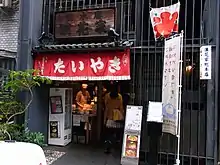
Taiyaki was first sold in Japan in 1909. It is essentially a reshaped form of imagawayaki, an already popular snack made by wrapping bean paste in flour skin.
Seijirō Kobe, founder of the store Naniwaya Sōhonten (浪花家総本店),[2] was having trouble selling his imagawayaki, so he decided to bake the cakes into fish shapes resembling tai, or red sea bream. Tai are considered a symbol of luck and fortune in Japan, and were an expensive fish only affordable by the higher classes or on special occasions. Masamori Kobe, the fourth owner of the store, stated that Seijirō wanted to give the ordinary people a taste of the expensive fish at low prices.[3]
Since its creation, taiyaki has evolved into many variations, with different ingredients being used for filling and batter, as well as variations in shapes and sizes.
Taiyaki was introduced to Korea during the Japanese colonial period, where it is known as bungeo-ppang.
During the postwar period, taiyaki spread to other Asian countries, as well as the rest of the world.
Gallery
- Taiyaki being made, 2014
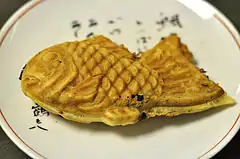 Standard taiyaki
Standard taiyaki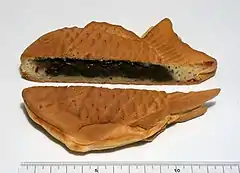 Cut taiyaki, showing the adzuki bean filling
Cut taiyaki, showing the adzuki bean filling Taiyaki with sweet potato filling
Taiyaki with sweet potato filling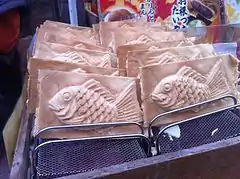 Square taiyaki with uncut edges, being sold in Ueno
Square taiyaki with uncut edges, being sold in Ueno Round taiyaki in the form of coiled fishes, being sold in Gunma
Round taiyaki in the form of coiled fishes, being sold in Gunma Mini taiyaki
Mini taiyaki.jpg.webp)
 Train-shaped taiyaki, being sold outside Narimasu Station
Train-shaped taiyaki, being sold outside Narimasu Station.jpg.webp) Taiyaki used as an ice cream holder, being sold in Taipei
Taiyaki used as an ice cream holder, being sold in Taipei.jpg.webp)
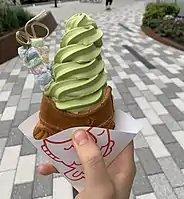 Taiyaki filled with matcha ice cream
Taiyaki filled with matcha ice cream
See also
- Bungeo-ppang, a similar Korean snack
- "Oyoge! Taiyaki-kun", a song about taiyaki
- Wagashi, Japanese confectionery
References
- Harrison, Thom (19 April 2023). "Fish-shaped sweet street food". Wagashi UK. Wagashi UK. Retrieved 25 April 2023.
- "浪花家総本店 | 麻布十番商店街". 麻布十番商店街 | 麻布十番商店街は東京都港区の商店街です。8月には麻布十番納涼祭りが開催されます。 (in Japanese). 2014-02-19. Retrieved 2023-01-09.
- Taiyaki no gyotaku : Zetsumetsu sunzen tennenmono taiyaki 37shu. Yasuhiko Miyajima, 康彦 宮嶋. Tōkyō: JTB. 2002. ISBN 4-533-04029-2. OCLC 676279355.
{{cite book}}: CS1 maint: others (link)